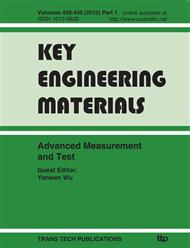[1]
M.H. Au, J.K. Liu, W. Susilo and T.H. Yuen, Certificate based (Linkable) ring signature, ISPEC2007, LNCS 4464, pp.79-92, springer-verlag, (2007).
DOI: 10.1007/978-3-540-72163-5_8
Google Scholar
[2]
Gentry,C. Certificate-based Encryption and the Certificate Revocation Problem. Eurocrypt 2003, LNCS 2656, pp.272-293, Springer-verlag, (2003).
DOI: 10.1007/3-540-39200-9_17
Google Scholar
[3]
W. Geiselmann, Rainer Steinwandt, A Key Substitution Attack on SFLASH, Cryptology ePrint Archive: Report 2004/245, 2004. http: /eprint. iacr. org/2004/245.
Google Scholar
[4]
S. Goldwasser, S. Micali and R. Rivest, A digital signature scheme secure against adaptive chosen-message attacks, SIAM Journal of computing, 17(2), pp.281-308, April (1988).
DOI: 10.1137/0217017
Google Scholar
[5]
Li,J., Huang, X., Mu, Y., Susil, W., Wu, Q., Certificate-based signature: Security model and efficient construction. EuroPKI 2007, LNCS 4582, pp.110-125. Springer-verlage, (2007).
Google Scholar
[6]
B.G. Kang, J.H. Park and S.G. Hahn, A certificate-based signature scheme, CT-RSA2004, LNCS 2964, pp.99-111, springer-verlag, (2004).
Google Scholar
[7]
Joseph K. Liu, Joonsang Baek, Willy Susilo, and Jianying Zhou, Cettificate-based Signature Scheme without Pairings or Random oracles, ISC2008, LNCS 5222, pp.285-297, (2008).
DOI: 10.1007/978-3-540-85886-7_20
Google Scholar
[8]
K. Nyberg and R.A. Rueppel, Message recovery for signature schemes based on the discrete logarithm, EUROCEYPTO'94, LNCS 165, pp.175-190, springer-verlag, (1994).
Google Scholar
[9]
Pointcheval. D and Stern. I, (1996)security proof for signature scheme", Eurocrypt, 96 in Lect. Notes comput. Sci. 1996. 1070. pp.387-398.
DOI: 10.1007/3-540-68339-9_33
Google Scholar
[10]
A. Shamir. Identity-based cryptosystems and signature schemes. CRYPTO'94, LNCS 196. Springer-verlag, pp.47-53, (1985).
Google Scholar
[11]
L.H. Wang,J. Shao Z.F. Cao,M. Mambo and A. Yamamura, A Certificate-based Proxy Cryptosystem with Revocalbe Prxoy Decryption Power, Indocrypt2007, LNCS 4859, pp.297-311, springer-verlag, (2007).
DOI: 10.1007/978-3-540-77026-8_22
Google Scholar
[12]
Waters,B. Efficient identity-based encryption without random oracles. EUROCRYPT 2005, LNCS 3494, pp.114-127, Springer, (2005).
DOI: 10.1007/11426639_7
Google Scholar
[13]
Y. Zheng, Identification, Signature and Signcryption using High Order Residues Modulo an RSA Composite, PKC 2001, LNCS 1992, Springer-verlag, pp.48-63, (2001).
DOI: 10.1007/3-540-44586-2_4
Google Scholar


